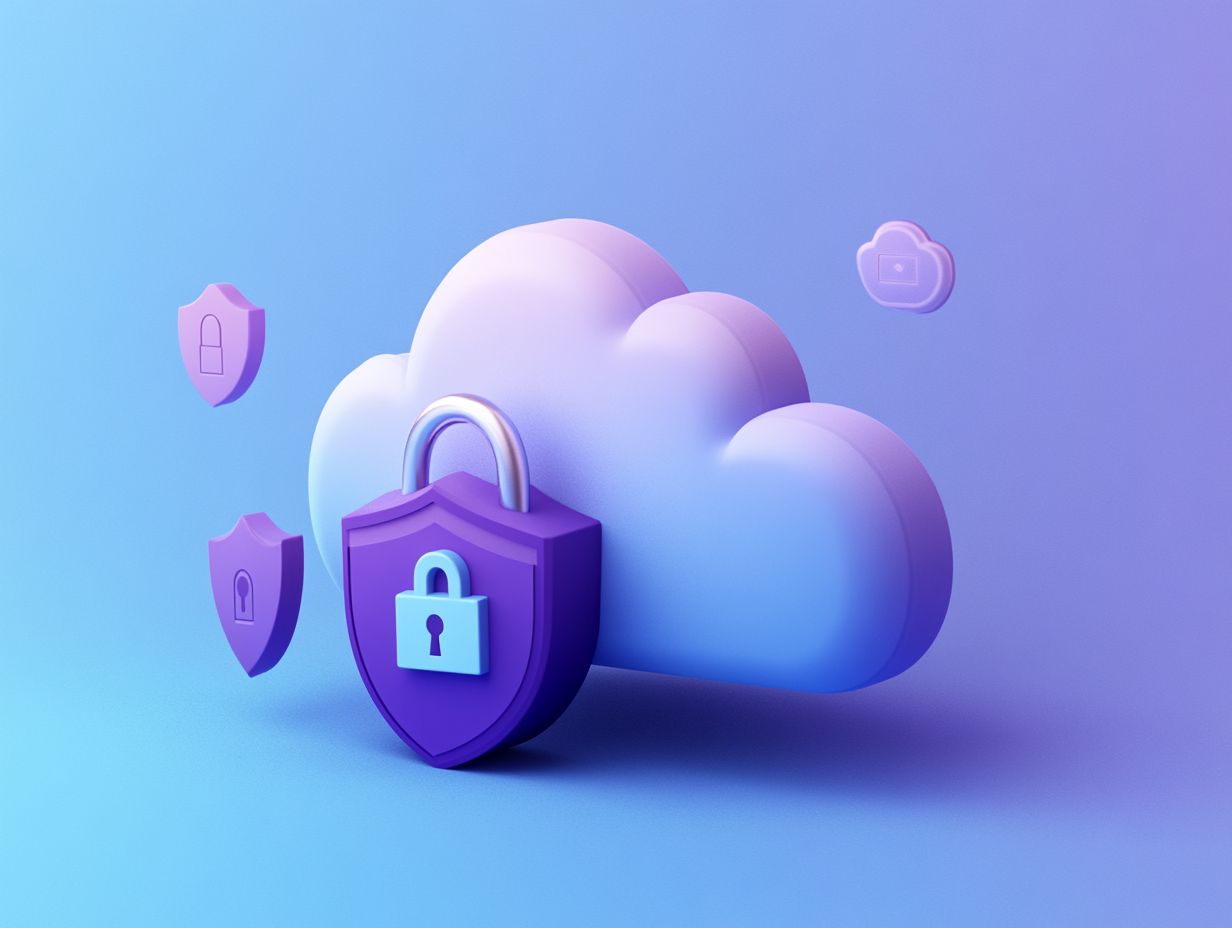Understanding Cloud Security: Key Principles Explained
In today s digital landscape, where businesses are increasingly leaning on cloud technology, grasping the nuances of cloud security is absolutely essential.
This article delves into the key principles that form the foundation of effective cloud security confidentiality, integrity, availability, accountability, and auditability.
You will also uncover common threats, such as data breaches and malware attacks, that could jeopardize your valuable data.
To safeguard your cloud environment, you ll discover best practices for secure data storage and the importance of conducting regular audits.
Immerse yourself in this information to effectively protect your cloud assets!
Contents
- Key Takeaways:
- Key Principles of Cloud Security
- Common Threats to Cloud Security
- Best Practices for Cloud Security
- Frequently Asked Questions
- What is cloud security, and why should you care?
- What are the key principles of cloud security?
- How does identity and access management play a role in cloud security?
- Why is data encryption important for cloud security?
- How does threat detection enhance cloud security?
- What is the role of compliance in cloud security?
Key Takeaways:

Confidentiality, integrity, availability, accountability, and auditability are essential keys to cloud security. These principles help protect your data from threats like data breaches and insider attacks.
Follow best practices such as secure data storage and regular audits to keep your systems strong and safe.
What is Cloud Security?
Cloud security includes policies, technologies, and controls designed to protect your data and applications in different cloud environments. This can be public, private, or hybrid.
Within the realm of cybersecurity, cloud security is absolutely vital. It ensures comprehensive protection against a myriad of threats, such as unauthorized access and identity management failures that could put your sensitive information at risk.
Grasping the fundamentals of cloud security is crucial for any organization transitioning to cloud infrastructure, as it involves risk management strategies that seamlessly align with regulatory compliance standards.
Effective cloud security transcends basic precautions by incorporating robust data protection mechanisms, like a way to keep your information safe by scrambling it, to ensure your information remains secure both at rest and in transit.
Identity management systems are essential in authenticating users and regulating access, thereby fortifying your sensitive data.
You must adhere to compliance frameworks, such as NIST 800-53 and HIPAA, which offer concrete guidelines for ensuring data safety and maintaining privacy.
These proactive measures not only help mitigate potential vulnerabilities but also foster trust among your clients and stakeholders, underscoring the critical importance of cloud security in today’s digital landscape.
Key Principles of Cloud Security
The key principles of cloud security center on establishing a robust security governance framework across your cloud environments. This involves a strong emphasis on critical aspects such as data protection, compliance auditing, identity management, and strict adherence to regulatory standards like GDPR and PCI 3.2.
These principles are meticulously crafted to mitigate risks related to unauthorized access and data breaches, all while promoting a Zero Trust security model that operates on the premise of no inherent trust in network components.
Confidentiality
Confidentiality in cloud security is a cornerstone principle. It ensures that sensitive data is accessible only to those with proper authorization. This keeps your information safe from unauthorized access using strong encryption.
Prioritizing data protection allows organizations like yours to reduce risks associated with data breaches while enhancing overall cloud security.
To maintain confidentiality effectively, cloud environments implement various security measures. For example, advanced encryption techniques, like AES (a method used to keep data secure), are routinely used to protect data both at rest and in transit. This means that even if data is intercepted, it remains unintelligible.
Strict access controls limit data access to individuals who genuinely need it for their roles. Sophisticated identity management systems authenticate users and monitor access in real time. Features like multi-factor authentication and role-based access controls enrich this security layer.
Cloud providers often include built-in security features, such as data loss prevention protocols and automated compliance auditing tools. These tools help organizations adhere to regulatory standards like GDPR and HIPAA.
This holistic approach not only protects sensitive information but also builds trust among clients and partners.
Integrity
Integrity in cloud security ensures the accuracy and consistency of your data throughout its lifecycle. It s about keeping your information unaltered and free from security issues or vulnerabilities.
This principle is crucial for building trust in your cloud infrastructure and protecting against unauthorized modifications. To achieve this, implement data integrity mechanisms like:
- Checksums: Verify data integrity.
- Hashing algorithms: Ensure data remains unchanged.
- Regular configuration reviews: Keep systems up to date.
These tools help you quickly identify any unauthorized changes or anomalies, preventing potential breaches. Don t underestimate the importance of security governance; it lays the groundwork for compliance with industry standards like NIST 800-53.
By adhering to these protocols, you can maintain strong data integrity, creating a secure environment that protects sensitive information and enhances your overall credibility.
Availability

Availability is paramount in cloud security, ensuring that your data and applications are accessible whenever you need them. Achieving this relies on effective strategies like disaster recovery and redundancy in hybrid environments.
This principle is vital for maintaining business continuity and meeting data protection standards. To boost availability, consider implementing failover systems that automatically reroute traffic to backup resources when primary systems encounter issues.
Load balancing helps distribute workloads across multiple servers, optimizing resource use and minimizing downtime. Regular uptime assessments are essential for identifying vulnerabilities and ensuring compliance with regulatory standards.
Preparing for potential outages means crafting comprehensive response plans that detail steps for rapid recovery, protecting against data loss and service interruptions. Implement these strategies today to ensure your data is always accessible!
Accountability
Accountability in cloud security emphasizes your responsibility, as both an individual and an organization, to implement and follow security policies and protocols. This ensures that your actions can be tracked and audited for compliance and security governance.
By embracing this principle, you foster a culture of responsibility and transparency within cloud environments. Employ methods like comprehensive logging and monitoring systems that provide real-time insights into user activities.
Regular compliance audits are crucial; they validate your adherence to established security frameworks. By aligning with recognized governance frameworks, you ensure a standardized approach to security.
This heightened accountability helps you identify potential vulnerabilities before they can be exploited and significantly enhances your proactive security posture. Being accountable is critical to maintaining security and trust among stakeholders while safeguarding sensitive data in the ever-evolving landscape of cloud computing.
Auditability
Auditability in cloud security is your key to ensuring that all processes and actions can be reviewed and verified. This gives your organization the power to demonstrate compliance with regulatory requirements while maintaining effective security governance.
Embracing this principle is essential for pinpointing potential vulnerabilities and elevating your overall cloud security practices.
The importance of maintaining thorough audit trails and security logs cannot be overstated. These logs provide a detailed account of user activity, system access, and any alterations made within your cloud environment.
Such records are crucial not only for detecting security breaches but also for preventing them in the first place.
Compliance audit frameworks help improve auditability by offering structured guidelines that you can adopt to align your practices with legal standards.
Incorporating third-party assessments introduces an additional layer of scrutiny and credibility. Experienced auditors bring specialized tools to the table, uncovering gaps and vulnerabilities that internal teams may overlook.
By weaving these elements together, you can significantly enhance your auditability, ensuring a robust security posture in an increasingly complex digital landscape.
Common Threats to Cloud Security
Common threats to cloud security encompass data breaches, malware attacks, and insider threats, each presenting substantial risks to organizations leveraging cloud infrastructures.
Grasping these vulnerabilities is essential for you to cultivate effective threat intelligence and implement proactive security measures.
Data Breaches
Data breaches pose one of the most formidable threats to cloud security. Often stemming from unauthorized access to sensitive information, they can result in significant financial and reputational harm.
To protect against these breaches, you must implement robust security measures and conduct regular compliance audits.
A common culprit behind these incidents is weak passwords that simply can t withstand hacking attempts, along with misconfigurations that leave vulnerabilities ripe for exploitation.
These oversights can trigger a chain reaction, compromising data integrity and allowing unauthorized access.
Here are some key practices to mitigate these risks:
- Utilize data loss prevention strategies that monitor and control data flow.
- Craft a comprehensive incident response plan that enables you to act swiftly in the event of a breach.
- Educate your team on secure password policies.
- Perform regular system audits to enhance your overall security posture.
Malware Attacks

Malware attacks represent a formidable threat to cloud security, taking advantage of system vulnerabilities to gain unauthorized access and disrupt services.
To effectively guard against the ever-evolving malware strategies targeting cloud infrastructures, you must remain vigilant and leverage threat intelligence.
Among the various malware types, ransomware is particularly nefarious. It encrypts files and demands a ransom for their release, while spyware operates stealthily, gathering sensitive information and often compromising data integrity.
To mitigate these risks, prioritize regular system updates to ensure that all software is equipped with the latest security patches.
Robust employee training programs are crucial; your team must be well-informed to identify and report phishing attempts, which frequently serve as common entry points for malware.
By combining the latest technology with strong human awareness, you can significantly bolster your cloud security against these serious threats.
Insider Threats
Insider threats pose a unique challenge in cloud security. These threats involve individuals within your organization who might intentionally or unintentionally jeopardize sensitive information through unauthorized access. To mitigate these risks, robust identity management and vigilant monitoring are essential.
Insider threats can be categorized into two primary types:
- Malicious insiders who deliberately exploit vulnerabilities for personal gain.
- Unintentional mistakes, where employees unknowingly put confidential data at risk due to a lack of awareness.
Organizations must implement strong strategies to combat these threats. For instance, establishing role-based access control limits data exposure based on an employee’s job responsibilities. Comprehensive training programs are also crucial. They emphasize the importance of data security and appropriate conduct.
These measures can significantly decrease the likelihood of both malicious and unintentional incidents, ultimately protecting sensitive information from potential breaches.
Best Practices for Cloud Security
Implementing best practices for cloud security is crucial for protecting your data and maintaining a secure cloud infrastructure. This is true whether you re utilizing serverless computing or a microservices architecture.
These best practices include:
- Regular compliance audits
- Robust data protection strategies
- The strategic use of encryption
- Automation to enhance security measures
By prioritizing these elements, you ensure your cloud environment remains resilient and secure!
Secure Data Storage and Encryption
Secure data storage and encryption are essential components of cloud security. They act as your first line of defense against unauthorized access, safeguarding the confidentiality of sensitive information stored in the cloud.
Implementing robust encryption protocols significantly mitigates the risk of data breaches and enhances your overall data protection strategy.
Among many encryption techniques, symmetric encryption stands out for its speed and efficiency, making it suitable for handling large volumes of data. In contrast, asymmetric encryption offers more security by employing dual keys, which enhances protection during data transmission.
Your decision between these methods often depends on specific use cases and regulatory requirements. Staying informed about compliance with legal standards is critical.
Adhering to these regulations fosters trust with clients and helps avoid potential penalties related to data mishandling.
Regular Audits and Updates
Conducting regular audits and updates is essential for maintaining cloud security. These activities empower you to identify vulnerabilities and ensure compliance with security governance frameworks.
These practices are crucial for adapting to emerging threats and sustaining a robust cloud infrastructure. By establishing a routine schedule for compliance audits and system updates, you can proactively pinpoint areas of concern before they escalate into significant issues.
Automating these processes minimizes human error and enhances efficiency. This allows your teams to focus on strategic initiatives instead of getting bogged down in manual tasks.
This streamlined approach enables you to adapt swiftly to regulatory changes, ensuring your security posture remains strong. Leveraging advanced technologies like AI and machine learning for auditing facilitates deeper analysis and superior threat detection. Stay ahead of threats!
Frequently Asked Questions

What is cloud security, and why should you care?
Cloud security protects your data and applications. It ensures your sensitive information is safe from cyber attacks and data breaches.
What are the key principles of cloud security?
Key principles of cloud security include identity and access management, data encryption, threat detection, network security, compliance, and disaster recovery. Together, these principles provide a secure environment for cloud-based applications and data storage.
How does identity and access management play a role in cloud security?
Identity and access management ensures that only authorized users access sensitive data and applications. This is achieved through processes like a method that requires more than one way to confirm your identity and role-based access controls.
Why is data encryption important for cloud security?
Data encryption protects sensitive information from unauthorized access. It transforms data into a code that can only be read with a key or password, keeping it safe from prying eyes.
How does threat detection enhance cloud security?
Threat detection uses tools to spot and respond to possible security threats. This includes monitoring for suspicious activities and identifying vulnerabilities to prevent attacks.
What is the role of compliance in cloud security?
Compliance means following laws and industry standards related to data protection. In cloud security, it includes adhering to regulations like GDPR and HIPAA to safeguard data.






